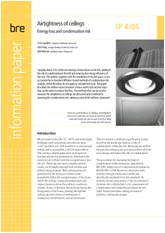Cart (0)

Book Badged Archived
Airtightness of ceilings. Energy loss and condensation risk. (Downloadable version)
Publisher
BRE Electronic Publications
Author
C Sanders, J Haig, N Rideout
Format
Subject / Keyword
Information paper IP4/06, cold roofs, lofts, attics, condensation, moisture transport, airflow, ventilation, thermal insulation, energy efficiency.
Published Date
31-Mar-2006
ISBN
1860819117
THIS PUBLICATION HAS BEEN ARCHIVED.
Whilst this publication can still be purchased some of the information in it has been superseded by more recent research and standards. The BRE Group does not accept any responsibility whatsoever for any loss or damage, including - without limitation - indirect or consequential loss or damage arising from use, or loss of use, of data or profits arising out of, or in connection with, the use of this document.
Book Badged Archived
Airtightness of ceilings. Energy loss and condensation risk. (Downloadable version)
List Price £ 9.00
